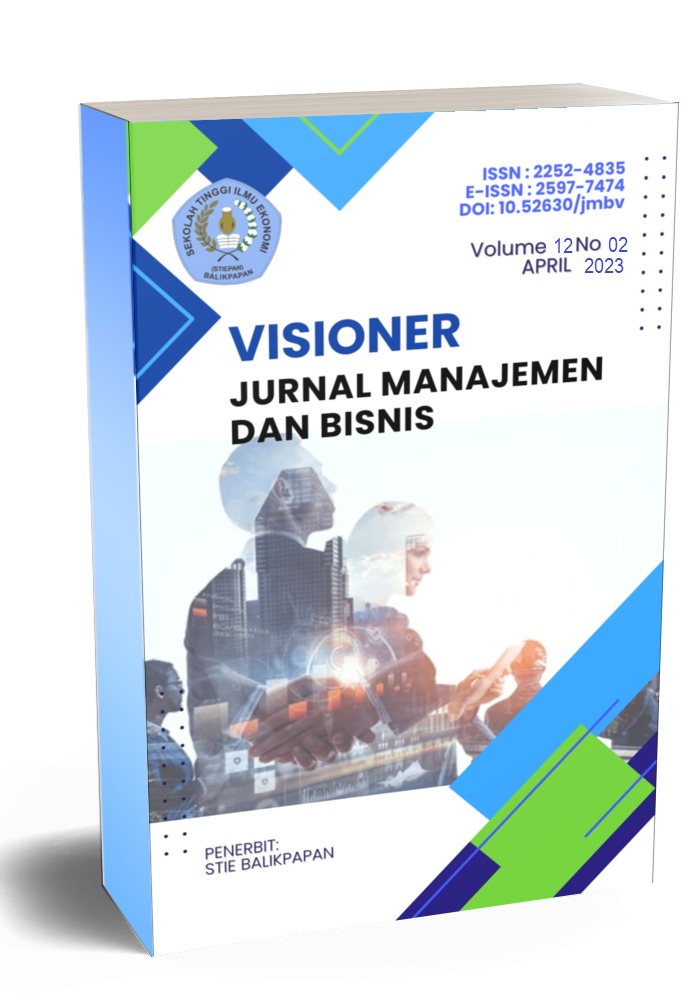THE EFFECT OF INFORMATION ASYMMETRICITY, LEVERAGE, COMPANY SIZE AND PROFITABILITY ON EARNINGS MANAGEMENT PRACTICES (EMPIRICAL STUDY ON MANUFACTURING COMPANIES IN THE FOOD AND BEVERAGE SUB-SECTOR LISTED ON THE INDONESIA STOCK EXCHANGE
DOI:
https://doi.org/10.52630/jmbv.v12.i02.45Keywords:
Earnings Management, Information Asymmetry, Leverage, Firm Size, ProfitabilityAbstract
Abstract
The purpose of this study is to provide empirical evidence about the effect of information asymmetry, Debt to Equity Ratio (DER), company size, Return On Assets (ROA) on earnings management practices in food and beverage sub-sector manufacturing companies listed on the Indonesia Stock Exchange for the period 2017-2021. Profit management is proxied using discretionary accruals, information asymmetry is proxied using the bid-ask spread formula, Leverage is proxied using the Debt to Equity Ratio (DER) formula, company size is proxied using the growth formula for firm size, Profitability is proxied using the Return On Assets (ROA) formula. The type of research used is quantitative. The data analysis technique used in this study is multiple linear regression analysis with the help of SPSS version 24. The population in this study are food and beverage companies listed on the Indonesia Stock Exchange for the 2017-2021 period consisting of 34 companies. Determination of the sample using the Pusposive Sampling method with a total sample of 60 samples from 12 selected companies. The results of this study indicate that information asymmetry has a positive and significant effect on earnings management, leverage has a positive and significant effect on earnings management, firm size has a negative and significant effect on earnings management, and profitability has a positive and significant effect on earnings management
References
A.Pearce&B.Robinson, R. (2018). Manajamen Strategis.
Aljana (2017). Pengaruh Profitabilitas, Struktur Kepemilikan dan Kualitas Audit terhadap Manajemen Laba (Studi pada Perusahaan Manufaktur yang Terdaftar di Bursa Efek Indonesia Tahun 2013-2015).
Andini & Pranaditya (2016). Pengaruh GCG dan Profitabilitas terhadap Penghindaran Pajak dengan Ukuran Perusahaan sebagai Variabel Moderating.
Ardeno Kurniawan (2022). Politik dan Akuntansi Keperilakuan.
Bambang Sugeng. (2020). Fundamental Metodologi Penelitian Kuantitatif (Eksplanatif).
Citra Monika, Hari Gursida (2018). Pengaruh Leverage dan Ukuran Perusahaan terhadap Manajemen Laba pada Perusahaan Manufaktur Subsektor Makanan dan Minuman yang terdaftar di Bursa Efek Indonesia Periode 2014- 2018.
Faradiza (2019). Fraud Pentagon Dan Kecurangan Laporan Keuangan.
Febriana. (2021). Dasar-dasar Analisis Laporan Keuangan.
Ghozali. (2018). Efektivitas Fintech pada UMKM.
Hantono. (2018). Laporan Keuangan dengan Pendekatan Rasio & SPSS.
Herawati (2019). Pentingnya Laporan Keuangan Untuk Menilai Kinerja Keuangan Perusahaan.
Hery (2016). Analisis Laporan Keuangan.
I Gusti Putu Darya, M. (2019). Akuntansi Manajemen.
Jayusman (2019). Analisis Laporan Keuangan Untuk Menilai Kinerja Perusahaan Pada Pt. Sinar Rejeki Bersama Pangkalan Bun.
Lela Nurlaela Wati (2019). Model Corporate Social Respocibility (CSR).
L.M. Samryn (2017). Pengantar Akuntansi.
Made (2014). Metode Penyusunan Skripsi Bidang Ilmu Akuntansi.
Marina (2017). Sistem Informasi Akuntansi.
Misbahuddin (2013). Analisis Data Penelitian dengan Statistik.
Morissan (2018). Manajemen Public Relations.
Ni Luh Gede Erni Sulindawati. (2017). Manajemen Keuangan.
Pranaditya (2016). Pengaruh Pertumbuhan Penjualan dan Leverage Terhadap Manajemen Laba.
Prihadi, T. (2019). Analisis Laporan Keuangan
Puspitasari (2019). Pengaruh Asimetri Informasi, Leverage dan Profitabilitas terhadap Manajemen Laba riil (studi empiris pada perusahaan manufaktur yang terdaftar di BEI periode 2004- 2013).
Putri & Rahmini (2021). Pengaruh Leverage terhadap Manajemen Laba dengan Corporate Governance pada Perusahaan F&B.
Rikaputri (2017). Pengaruh Debt To Equity Ratio, Size, Audit Committee Diligence, Dividend Policy Pada Praktik Manajemen Laba.
Rioni (2021). Pengaruh Perencanaan Pajak terhadap Manajemen Laba pada Perusahaan Non Manufaktur yang terdaftar di Bursa Efek Indonesia.
Rizki (2021). Pengaruh Asimetri Informasi, Leverage, Ukuran Perusahaan Dan Profitabilitas Terhadap Manajemen Laba (Studi Empiris pada Perusahaan Manufaktur Yang Terdaftar di Bursa Efek Indonesia Periode 2016-2018).
Ruki Ambar Arum (2022). Analisis Laporan Keuangan.
Safira (2020). Pengaruh Profitabilitas dan Leverage terhadap Manajemen Laba pada Perusahaan Manufaktur Sektor Makanan dan Minuman yang terdaftar di Bursa Efek Indonesia pada Tahun 2016-2020.
Sianturi, N. (2021.). Analisa Laporan Keuangan untuk Teknik dan Ekonomi.
Sitanggang Purba (2022). Pengaruh Asymetric Informaition, Leverage Dan Ukuran Perusahaan Terhadap Manajemen Laba (Studi Empiris Pada Perusahaan Manufaktur Yang Terdaftar Di Bursa Efek Indonesia Tahun 2011-2013).
Sri Mangesti Rahayu (2018). Analisis Pengaruh Gender Direksi dan Komisaris, Manajemen Laba serta Analisis Pengaruh Gender Direksi dan Komisaris, Manajemen Laba serta Kinerja Perusahaan terhadap Kompensasi Manajemen Puncak.
Sudarmanto (2021). Good Corporate Governance.
Sudjatmiko, S. (2017). Corporate Culture.
Sugiyono (2013). Metode Penelitian untuk Perguruan Tinggi.
Sugiyono. (2021). Metode Penelitian Kuantitatif Kualitatif dan R&D.
Sujarweni (2019). THE MASTER BOOK OF SPSS.
Sunarsi & Ahmar (2022). Strategi Kepemimpinan Biaya, Diferensiasi, Manajemen Keberlanjutan dan Pengelolaan Laba.
Suwardjono. (2019). Angewandte Chemie International Edition.
W.Zimmerer, T. (2019). Kewirausahaan dan Manajemen Usaha Kecil.
Yasa (2020). Pengaruh Ukuran Perusahaan, Leverage dan Profitabilitas terhadap Manajemen Laba pada Perusahaan Manufaktur di BEI Tahun 2016-2018.
Downloads
Published
Issue
Section
License
Copyright (c) 2025 Vidiah Wati (Author)

This work is licensed under a Creative Commons Attribution 4.0 International License.
License Terms
 VISONER : Jurnal Manajemen dan Bisnis (VJMB) by STIE Balikpapan is licensed under a Creative Commons Attribution 4.0 International License.
VISONER : Jurnal Manajemen dan Bisnis (VJMB) by STIE Balikpapan is licensed under a Creative Commons Attribution 4.0 International License.
You are free to:
- Share ” copy and redistribute the material in any medium or format
- Adapt ” remix, transform, and build upon the material for any purpose, even commercially.
Under the following terms:
-
Attribution ” You must give appropriate credit, provide a link to the license, and indicate if changes were made. You may do so in any reasonable manner, but not in any way that suggests the licensor endorses you or your use.
- No additional restrictions ” You may not apply legal terms or technological measures that legally restrict others from doing anything the license permits.












